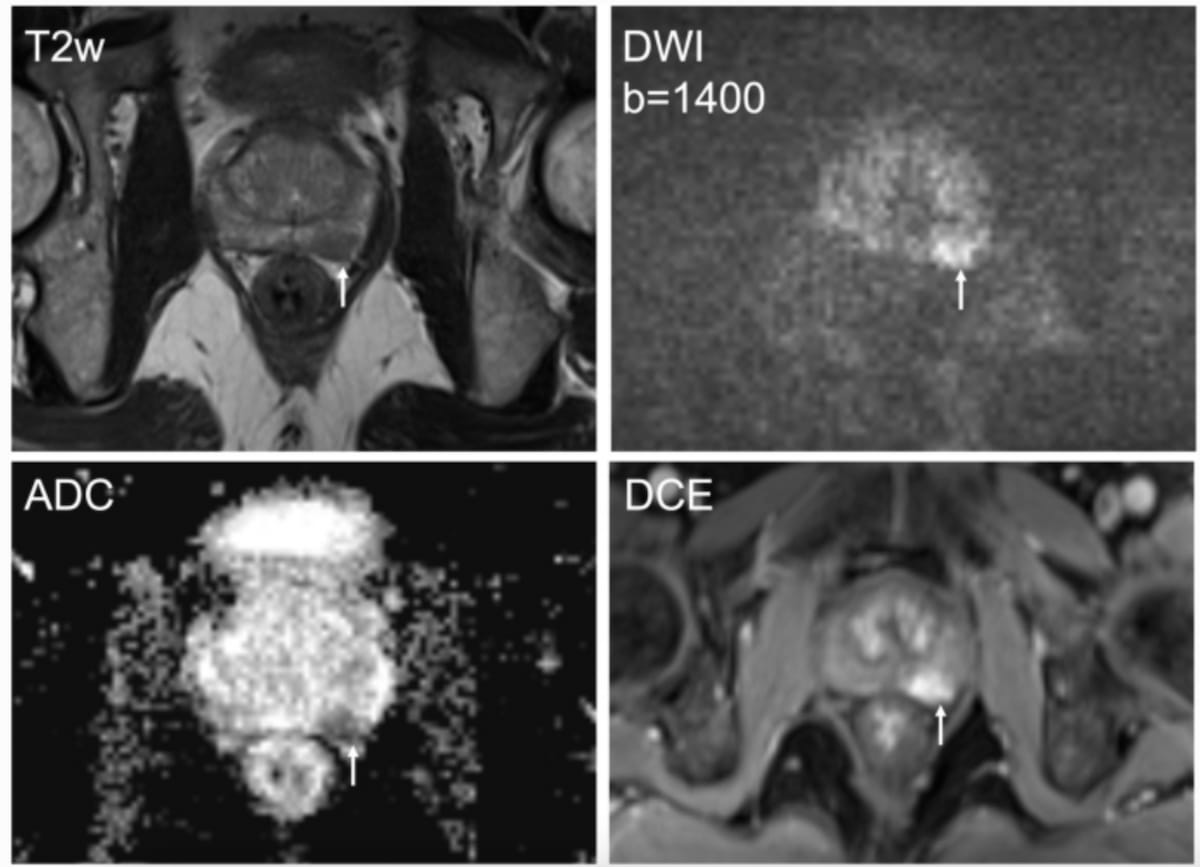For biopsy-naïve patients with suspected prostate cancer, an emerging model that emphasizes cognitive magnetic resonance imaging targeted biopsy (MRTB) and clinical factor consideration may provide a viable alternative to systematic prostate biopsy.
For the retrospective study, recently published in Insights into Imaging, researchers identified independent predictive factors for clinically significant prostate cancer (csPCa) with cognitive MRTB, and subsequently compared clinical and magnetic resonance imaging (MRI) models with a combination model of multiparametic MRI (mpMRI) and clinical factors.
The cohort was comprised of 201 patients in the model development cohort and 73 patients in the validation cohort, all of whom had combined cognitive MRTB and systematic biopsy (SB), according to the study.
The researchers found that prostate-specific antigen density (PSAD), index lesion (IL) on the peripheral zone, age and PI-RADS 4 and 5 scores were independent predictive factors for detecting csPCa via cognitive MRTB.
The combined model, incorporating mpMRI findings and clinical parameters, demonstrated an 18 percent higher AUC (88 percent) than the clinical model (70 percent) in validation testing and was slightly higher than the AUC for the MRI-only model (86 percent). The study authors also found that the combined model offered more net benefit (predicting csPCa while reducing additional systematic biopsy) than the clinical and MRI-only models at risk thresholds between 10 to 80 percent with the optimal risk threshold being between 50 to 65 percent.
Specifically, at a risk threshold of 60 percent, validation testing revealed the combined model would prevent unnecessary systematic biopsy in 32 of 73 patients (43.8 percent) and miss one csPCa diagnosis in 34 patients (2.9 percent), according to the study authors.
“The combined model, (incorporating) both clinical and mpMRI characteristics, achieved greater net benefit and would help clinical decision-making comprehensively,” wrote study co-author Bin Song, M.D., who is affiliated with the Department of Radiology at the West China Hospital of Sichuan University in China, and colleagues. “With a risk threshold set at 60%, 43.8% of patients with very high risk (greater than 60%) of detecting csPCa on MRTB would be advised to avoid (systematic biopsy) both in the development and validation cohorts. Accordingly, a total of 1440 systematic cores would be saved at the expense of missing only two cases of csPCa.”
Three Key Takeaways
- Cognitive magnetic resonance imaging targeted biopsy (MRTB) shows promise. The study suggests that for biopsy-naïve patients with suspected prostate cancer, a model emphasizing cognitive MRTB may provide a viable alternative to systematic prostate biopsy. Cognitive MRTB, which targets specific lesions identified through magnetic resonance imaging (MRI), demonstrated effectiveness in detecting clinically significant prostate cancer (csPCa).
- Independent predictive factors for csPCa detection. The study identified specific factors that independently predicted the detection of clinically significant prostate cancer through cognitive MRTB. These factors include prostate-specific antigen density (PSAD), index lesion (IL) on the peripheral zone, age, and PI-RADS 4 and 5 scores. These factors contribute to a more nuanced and accurate assessment of the likelihood of csPCa.
- Combined model enhances diagnostic accuracy and reduces unnecessary biopsies. The combination model, incorporating both multiparametric MRI findings and clinical parameters, showed an 18 percent higher Area Under the Curve (AUC) compared to the clinical model alone in validation testing. The combined model also offered more net benefit by predicting csPCa while reducing additional systematic biopsy. At a risk threshold of 60 percent, the combined model prevented unnecessary systematic biopsies in a significant percentage of patients without compromising diagnostic accuracy. The authors emphasize that this combined model approach provides a balanced biopsy strategy, considering both benefits and risks in managing patients with suspected csPCa.
The study authors noted that previous literature reports have recommended avoiding additional systematic biopsy beyond mpMRI in patients with PI-RADS 5 due to marginal increases in diagnosing csPCa.
In validation testing for patients with PI-RADS 5 lesions, the researchers found that performing only MRTB would prevent systematic biopsies in 24.7 percent of patients and miss one case of csPCa out of 34 patients (2.9 percent).
(Editor’s note: For related content, see “Can MRI Findings Help Predict Toxicity After Radiotherapy for Prostate Cancer?,” “Multinational Study Suggests High Variability with Quality of Prostate MRI” and “Diagnostic Imaging’s Top Five Prostate Imaging Content of 2023.”)
Overall, Song and colleagues said the combination model approach, emphasizing cognitive MRTB and relevant clinical factors, offers a more balanced biopsy approach to managing benefits and risks in patients with suspected csPCa.
“The predictive model might be useful in making a decision about which patient(s) could safely avoid unnecessary (systematic biopsy) in addition to MRTB in biopsy-naïve patients and may offer the best compromise between the risk of missing csPCa, biopsy complications, and medical burden,” emphasized Song and colleagues.
(Editor’s note: For additional related content on prostate cancer imaging, click here.)
